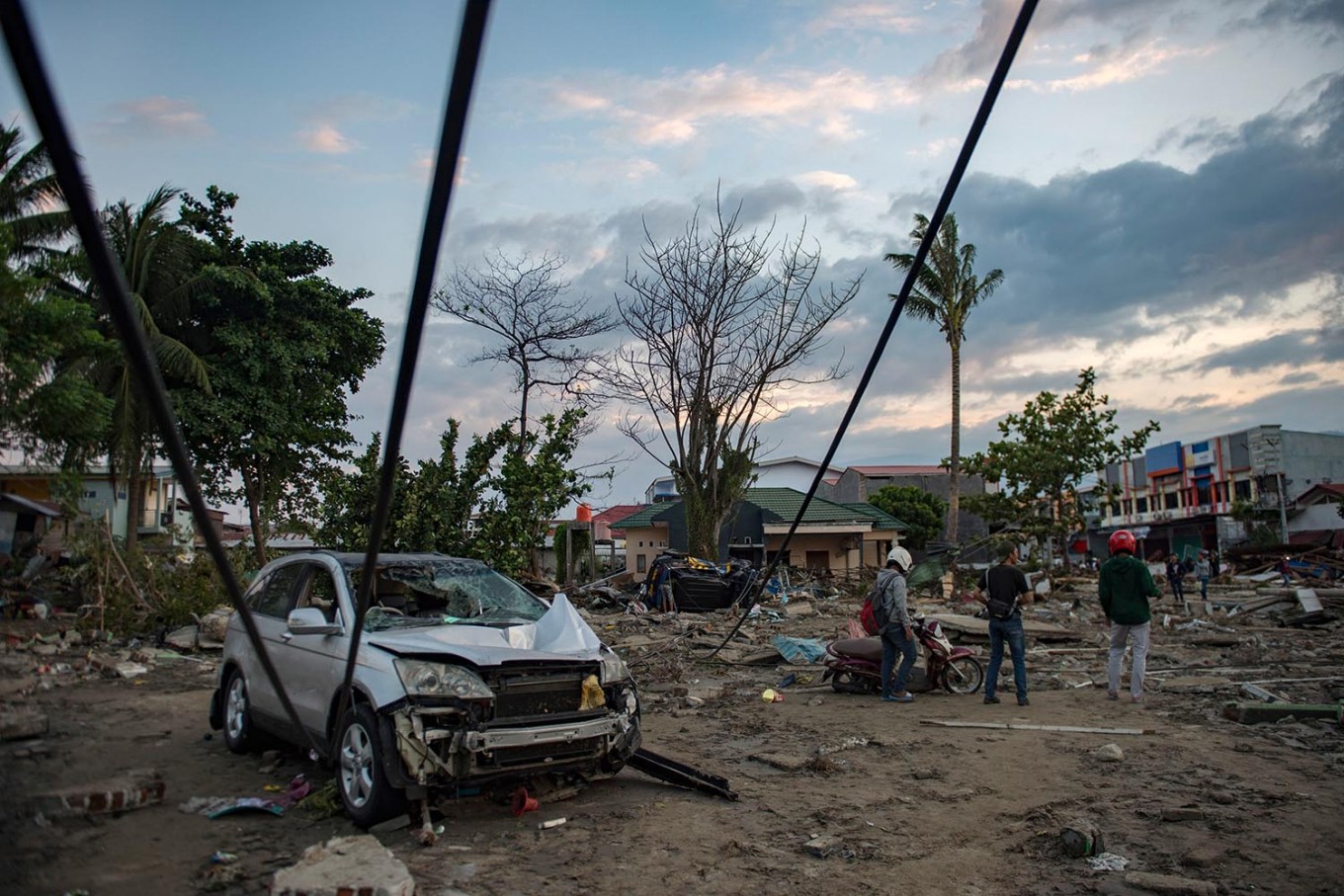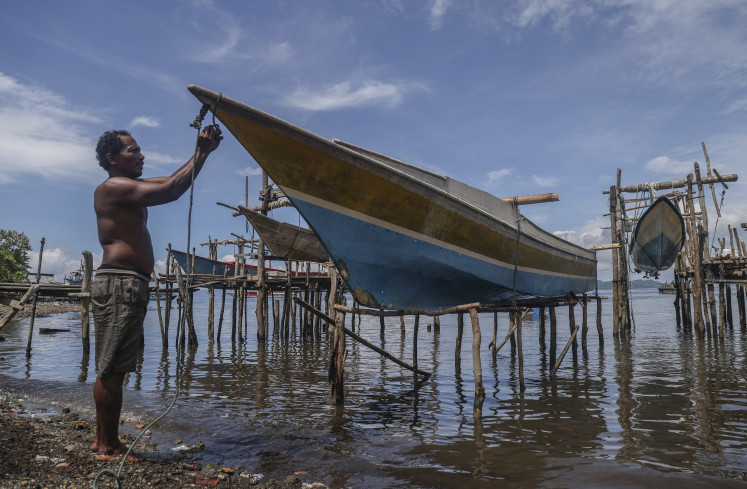Popular Reads
Top Results
Can't find what you're looking for?
View all search resultsPopular Reads
Top Results
Can't find what you're looking for?
View all search resultsInaTEWS: About more than technology
Harsh criticism over Indonesia´s tsunami early warning system (InaTEWS) seems to be dominating the current discourse in the aftermath of the Sulawesi earthquakes and tsunami.
Change text size
Gift Premium Articles
to Anyone
H
arsh criticism over Indonesia´s tsunami early warning system (InaTEWS) seems to be dominating the current discourse in the aftermath of the Sulawesi earthquakes and tsunami. A recurring topic is the allegedly malfunctioning of the system, particularly in regard to vandalized buoys and the need for more monitoring technology to improve warnings.
Unfortunately, not many seem to remember that it was a conscious and informed decision taken within InaTEWS in 2010 to no longer rely on the buoy system, which proved to be very vulnerable, cost intensive and not very effective in situations when short warning times caused by near-field tsunamis did occur.
Cost-benefit calculations showed that maintenance of the ocean-going buoy system would consume almost 50 percent of the overall budget for the maintenance and operation of the warning system as a whole.
It was decided to base InaTEWS on an extensive seismic network, tide gauges and GPS stations with results processed by a decision support system that includes a large database of tsunami threat scenarios. Therefore, the absence of buoys was intended and is not a symptom of a malfunctioning system.
Sadly, this controversy has been taken up extensively by international media, damaging the reputation of Indonesia and InaTEWS.
A closer look at the facts in the Sulawesi case reveals that first of all, InaTEWS issued a warning within 5 minutes after the earthquake was detected, indicating affected areas and warning levels based on expected wave heights — which proved to be quite close to the actual observed tsunami.
The warning was transmitted to the National Disaster Mitigation Agency (BNPB), local governments, the media and the public via various channels, like websites and social media. So far, so good.
On the other hand, it has to be stated that the tsunami obviously took many people by surprise, indicated by the high loss of lives. This can hardly be attributed to the overhasty lifting of the warning, which is questioned for good reasons. Instead, it clearly indicates that there is a significant and deadly gap in the tsunami warning chain, which impedes the community at risk from reacting properly to the issued warnings.
This gap is not entirely new. It has been observed and pointed out on several occasions during the last several years. InaTEWS’ task is to provide vital data on earthquakes and tsunamis to local governments and authorities responsible for guiding their communities´ reaction and for making the decision whether or not to call for an evacuation.
In order to fulfill this task, local governments would need to set up local operation centers working on a 24/7 basis. It requires properly trained staff authorized to analyze InaTEWS warnings and to decide on an evacuation within minutes, usually while the earthquake is still going on. It further requires local governments to set up warning dissemination mechanisms to instantly reach the community at risk.
This set-up was chosen as it represents the common distribution of tasks and mandates in the field of disaster risk management in Indonesia and, secondly, because heads of local governments should be in control of far-reaching decisions in case a public mass evacuation has to be ordered.
Unfortunately, the framework conditions to implement these arrangements are not available in most regions along Indonesia’s tsunami-prone areas.
Most regions lack the financial and human resources as well as the capacities for them. And as long the dissemination of warnings and guidance to the community has not been established as a mandatory public service for local administrations, it merely depends on a country’s political commitment, which is often not strong and persistent enough. In summary, this turns the task into a mission impossible.
Addressing this gap is the key to assure that InaTEWS achieves its goal of saving human lives. It might require a thorough review of the current arrangement of the warning chain, leaving the decision on public evacuation exclusively in the hands of institutions that have been proven to possess sufficient capabilities and resources. It has always been understood that tsunami early warning systems serve as a complementary mechanism to the warnings provided by nature.
The first line of defense — and this is a very individual one — is the reaction to ground shaking by the earthquake itself. It is hard to comprehend that people would still stick to their activities on the seashore in Palu, Central Sulawesi, after experiencing violent ground shaking and witnessing buildings collapsing just behind them. Is it pure panic that stops people from taking a rationale decision?
A couple of weeks ago, a tsunami warning by the Meteorology, Climatology and Geophysics Agency (BMKG) for northern Lombok, West Nusa Tenggara, was heavily criticized because it created panic among residents and visitors in Lombok and on the Gili Islands.
But, as it turned out, the issued warning was based on an expected scenario that very well matched with the observed sea level fluctuations that followed the earthquake. In this case, the BMKG issued an “advisory” for only two regions and set just one region in northern Lombok on “warning” level.
An “advisory” does not require any evacuation and there was no warning level at all for the Gili Islands. Nevertheless, people just heard “tsunami warning” and, with the Aceh scenario in mind, many panicked. But let’s be honest, how many of you really know what the three InaTEWS warning levels are, what reactions are required and that the warning levels only apply to certain warning segments that mostly represent district coast lines? A large-scale public information campaign on InaTEWS basics is long overdue!
Experiences show that survival of a tsunami depends very much on the ability of the individual person to judge the respective situation, having basic but solid knowledge of tsunami characteristics, the local warning services and a simple plan of what to do in such situation. Strengthening awareness and knowledge at the community level should be definitely another important pillar and a possible solution to mitigating the loss of lives.
Our suggestion: Let us learn the right lessons from this catastrophe and, above all, put them into practice.
***
Harald Spahn is a geologist who worked in Indonesia in 2006-2013 as team leader for capacity building within the (German-Indonesian Tsunami Early Warning System) GITEWS and Project for Training, Education and Consulting for Tsunami Early Warning Systems (PROTECTS) projects. Dr. Jörn Lauterjung heads the Division Scientific Infrastructures at GFZ Potsdam and was head of GITEWS and PROTECTS from 2005 to 2013.











